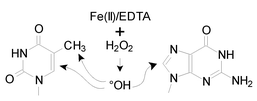Comparative study of base damage induced by gamma radiation and Fenton reaction in isolated DNA
Abstract
Both γ-irradiation and Fenton reaction generate oxidising species that damage isolated DNA. The comparison of the distribution of oxidised bases suggested that the Fenton reaction produces


 Please wait while we load your content...
Please wait while we load your content...